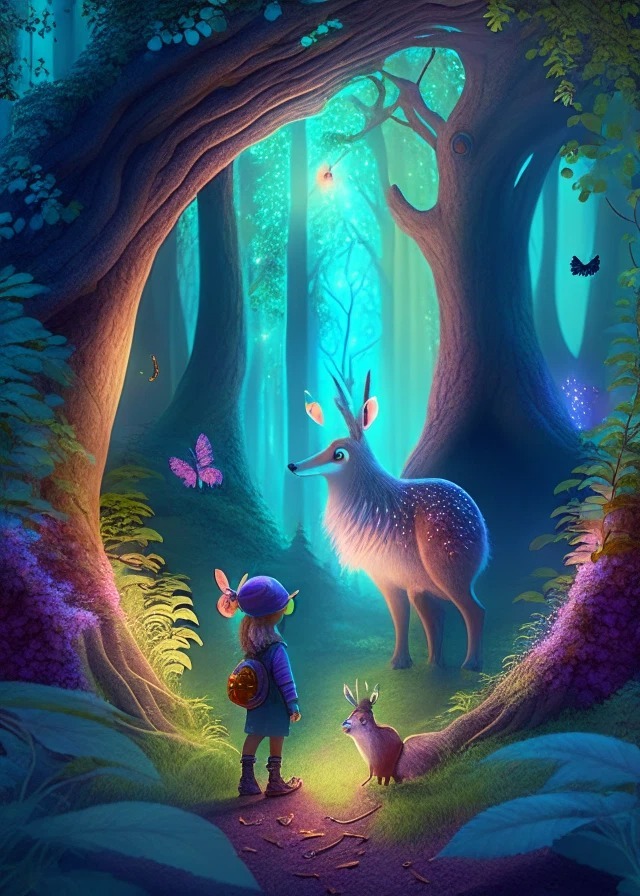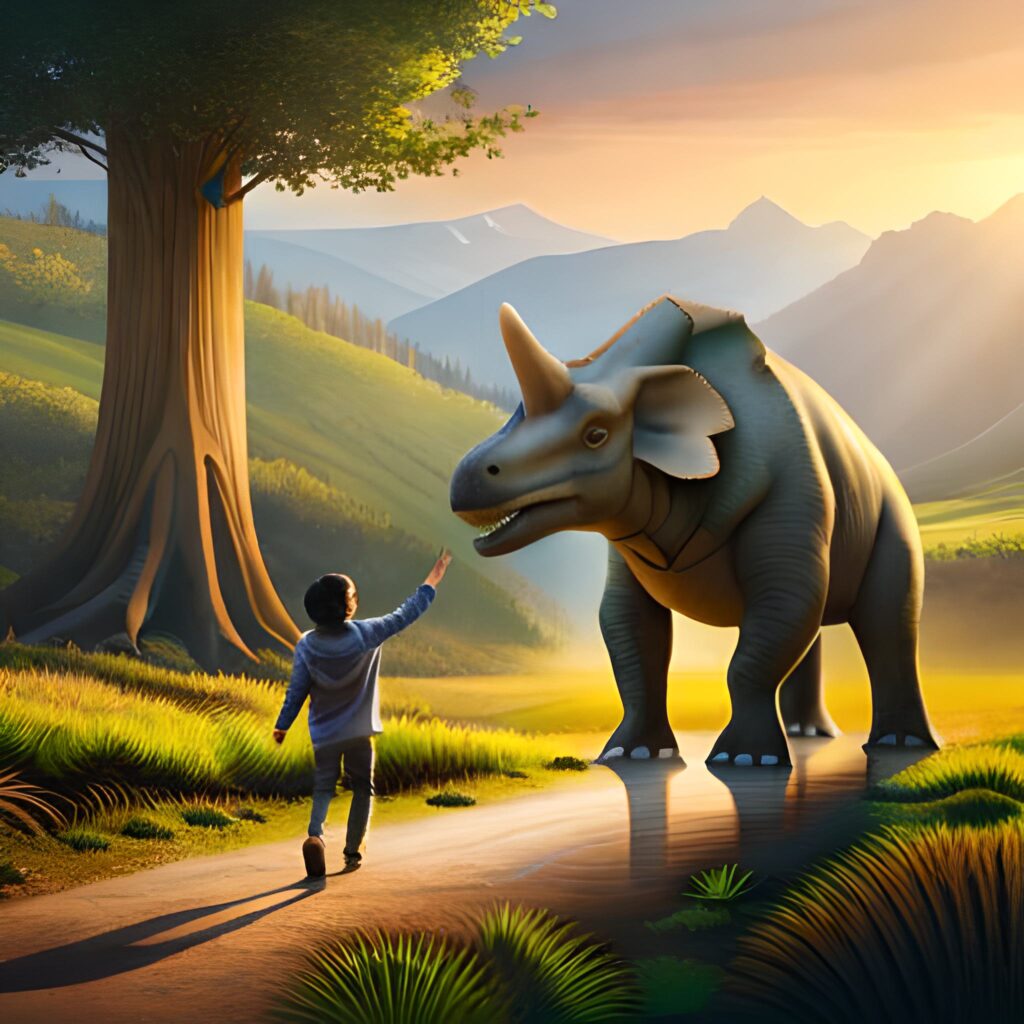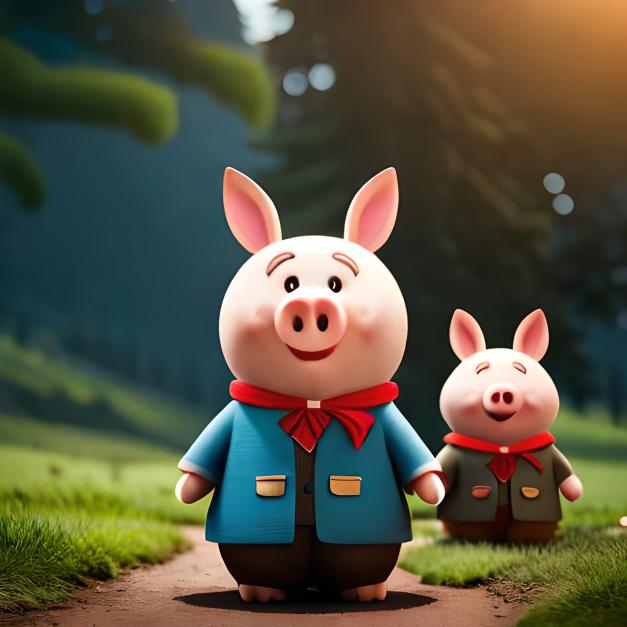Fiction is a genre of short stories for kids that encompasses imaginative and made-up narratives. It is an incredibly popular genre because it appeals to children’s imagination, curiosity, and emotions in various ways.
Firstly, fiction stories for kids allow their imagination to soar. They transport young readers to fantastical worlds, where anything is possible. Children are naturally curious and eager to explore new ideas and concepts, which fiction stories cater to by creating unique settings, characters, and scenarios. This genre enables children to escape from reality and engage with imaginary worlds that spark their creative thinking and allow them to dream beyond the boundaries of their everyday lives.
Moreover, fiction stories for kids tap into their inherent curiosity. Children are fascinated by the unknown and the inexplicable. Fiction often incorporates elements of mystery, magic, and the supernatural, fueling their curiosity and prompting them to seek answers to questions posed by the narrative. This genre encourages children to be inquisitive, think critically, and analyze information, thereby fostering their intellectual development.
Fiction Short Stories Genre: Examples
Best Adventure Stories of all Time
There is a vast range of genres within fiction, so I will focus on three popular genres: science fiction, mystery, and romance. These genres were chosen due to their significant impact and broad appeal. I will provide a brief summary and analysis of representative works from each genre, highlighting their main features and elements, as well as their appeal, diversity, and relevance.
Adventure Stories in English with Pictures
Fiction Short Stories Genre: Authors
Some of the famous authors of the genre of fiction and their contributions to the development and popularity of the genre, along with their notable works and achievements, are as follows:
- Jane Austen: Jane Austen is known for her witty social commentary and is considered one of the most influential writers in the history of English literature. Her novels, such as “Pride and Prejudice,” “Sense and Sensibility,” and “Emma,” explored the lives of women in the 19th century and portrayed love, marriage, and societal expectations. Austen’s works continue to captivate readers with their vivid characters and satirical observations on British society.
2. Ernest Hemingway: Ernest Hemingway, an American author, is recognized for his spare and economical writing style, which had a significant impact on modern fiction. Hemingway’s works, such as “The Old Man and the Sea,” “A Farewell to Arms,” and “For Whom the Bell Tolls,” are characterized by their intense portrayal of human struggle and the exploration of themes like war, masculinity, and love. Through his concise prose and depiction of noble but flawed characters, Hemingway revolutionized 20th-century literature.
3. Virginia Woolf: Virginia Woolf was an English writer who made significant contributions to modernist literature and feminist literary criticism. Her novels, including “Mrs. Dalloway,” “To the Lighthouse,” and “Orlando,” delved into the complexities of human consciousness and challenged conventional narrative structures. Woolf’s stream-of-consciousness writing style and exploration of gender and identity continue to inspire writers and readers alike.
4. Gabriel García Márquez: Gabriel García Márquez, a Colombian author, is often credited with popularizing the literary style known as magical realism. His masterpiece, “One Hundred Years of Solitude,” tells the story of the Buendía family and incorporates fantastical elements into a vivid portrayal of Latin American history and culture. Márquez’s blending of reality and imagination influenced countless writers, enriching the genre with mythic themes and evocative storytelling.
5. J.K. Rowling: J.K. Rowling is a British author best known for creating the beloved Harry Potter series. Through her seven books, beginning with “Harry Potter and the Philosopher’s Stone” (published as “Harry Potter and the Sorcerer’s Stone” in the United States), Rowling transported readers to the magical world of Hogwarts, captivating both young and adult audiences. With her complex characters, intricate plots, and themes of friendship, bravery, and the fight against evil, Rowling reinvigorated the fantasy genre and inspired a new generation of readers and writers.
These authors’ contributions to the genre of fiction elevated storytelling, challenged norms, and expanded the literary landscape. Through their distinct styles, exploration of societal issues, and imaginative world-building, they have left an indelible mark on literature and continue to influence aspiring writers and captivate readers around the world.
Fiction Short Stories Genre : History
The genre of fiction emerged thousands of years ago, making it difficult to pinpoint a specific time and place of its origin. However, the earliest known fictional works can be traced back to ancient civilizations such as Mesopotamia, ancient Egypt, and ancient Greece. These early works often took the form of myths, legends, and epic poetry.
Historically, the development of fiction was influenced by various cultural, social, and technological factors. One significant factor was the advent of writing systems, which allowed stories and narratives to be documented and transmitted across generations. Additionally, the rise of complex societies, increased leisure time, and the introduction of printing technology during the Renaissance all played a role in fostering the growth of fiction.
Throughout history, numerous pioneers and innovators have contributed to the evolution of fiction. Some notable figures include:
- Homer: The ancient Greek poet, known for his epic poems “The Iliad” and “The Odyssey,” which laid the foundation for storytelling and narrative structure.
- Geoffrey Chaucer: The English poet who wrote “The Canterbury Tales,” a collection of stories told by a diverse group of pilgrims, showcasing various literary styles and themes.
- Miguel de Cervantes: The Spanish writer who penned “Don Quixote,” often regarded as the first modern novel, incorporating elements of satire and metafiction.
- Jane Austen: The English novelist known for her works such as “Pride and Prejudice” and “Sense and Sensibility,” which examined themes of social class and the role of women in society.
- Leo Tolstoy: The Russian author who wrote “War and Peace” and “Anna Karenina,” crafting deeply layered characters and exploring themes of morality, love, and human nature.
There have been many landmark works and trends within the genre of fiction. Some notable examples include:
– The development of the novel during the 18th century with works such as Daniel Defoe’s “Robinson Crusoe” and Samuel Richardson’s “Pamela.”
– The emergence of the Gothic novel in the late 18th century with works like Horace Walpole’s “The Castle of Otranto” and Ann Radcliffe’s “The Mysteries of Udolpho,” exploring themes of horror, romance, and suspense.
– The rise of the Realist novel in the 19th century, exemplified by authors such as Gustave Flaubert (“Madame Bovary”) and Fyodor Dostoevsky (“Crime and Punishment”), who sought to depict everyday life and human experiences in a more objective and truthful manner.
– The development of literary movements, such as Modernism in the early 20th century, which challenged traditional narrative structures and experimented with stream of consciousness techniques (as seen in James Joyce’s “Ulysses”).
– The advent of postmodern fiction in the late 20th century, characterized by irony, metafiction, and self-reflexivity, as displayed in works like Italo Calvino’s “If on a winter’s night a traveler” and Salman Rushdie’s “Midnight’s Children.”
These examples only scratch the surface of the rich and diverse history of fiction. The genre continually evolves as new writers and literary movements emerge, reflecting the ever-changing historical, cultural, and social landscapes of their respective eras.
Fiction Short Stories Genre: Characteristics
The genre of fiction encompasses a wide range of literary works, but some key characteristics are commonly found across different types and subgenres.
- Language: Fiction utilizes language to tell a story and create a narrative. It can vary depending on the intended audience, but it often employs descriptive and evocative language to engage readers and bring the fictional world to life.
- Plot: Fiction typically revolves around a plot, which refers to the sequence of events that drive the story forward. This can include elements such as conflict, rising action, climax, and resolution, creating a structure that keeps readers engaged.
- Characters: Characters play a central role in fiction, serving as the protagonists and/or antagonists who drive the story. They can be developed through dialogue, actions, thoughts, and interactions with others, allowing readers to form connections and become emotionally invested in their journey.
- Setting: The setting refers to the time, place, and environment in which the story takes place. Fiction often uses detailed descriptions to transport readers to different worlds, whether they are realistic or fantastical, providing a vivid backdrop for the narrative.
- Tone: Tone refers to the author’s attitude or perspective towards the subject matter and readers. Fiction can employ a range of tones, such as humorous, mysterious, romantic, serious, or satirical, to elicit specific emotions or reactions from readers.
- Themes, topics, and messages: Fiction addresses a wide array of themes, topics, and messages. Some common themes in children’s fiction include friendship, courage, coming-of-age, family, self-discovery, imagination, and overcoming obstacles. Fiction allows children to explore different perspectives, learn about different cultures and experiences, and develop empathy and critical thinking skills.
Relating to kids’ interests and needs: Fiction appeals to children’s interests in storytelling, imagination, and exploring new worlds. It allows them to visualize and experience different situations, characters, and settings beyond their own lives. Additionally, fiction can address topics and issues that kids may encounter in their own lives, such as bullying, loss, or self-esteem, providing them with insights, support, and avenues for personal growth and understanding.
Fiction Short Stories Genre: Benefits
Reading fiction can offer numerous benefits for kids, enhancing their reading comprehension, vocabulary, critical thinking skills, broadening their horizons, enriching their culture, fostering creativity, and motivating them to pursue their goals and dreams.
- Reading comprehension: Fiction exposes kids to various writing styles, story structures, and narrative techniques, improving their ability to understand and identify different elements within a story. By reading fiction from various authors and genres, children can develop diverse perspectives and interpretations, ultimately strengthening their comprehension skills.
- Vocabulary expansion: Fiction introduces children to new words, phrases, and language patterns. Through exposure to a wide range of vocabulary in different contexts, kids can enhance their vocabulary skills, expanding their word knowledge and improving their verbal expression.
- Critical thinking skills: Fiction often presents complex characters, intricate plots, and thought-provoking themes, which can stimulate critical thinking in kids. They are encouraged to analyze the motives, actions, and consequences of the characters, as well as analyze the underlying messages and themes in the story. This fosters their ability to think critically and develop their own opinions and perspectives.
- Broadening horizons: Fiction introduces children to different cultures, time periods, and places they may not have encountered otherwise. By exploring various settings and diverse characters, kids gain a broader understanding of the world, promoting tolerance, empathy, and respect for different cultures and perspectives.
- Enriching culture: Fiction often incorporates cultural references, historical events, and societal issues. By reading diverse fiction, children can gain a deeper understanding and appreciation of different cultural traditions, historical contexts, and societal challenges, enhancing their cultural knowledge and sensitivity.
- Fostering creativity: Fiction sparks imagination and allows children to envision different scenarios, settings, and characters. This encourages creative thinking and the ability to generate new ideas. Through reading fiction, kids can explore imaginary worlds, build their imaginative skills, and develop their own creativity in writing, storytelling, and problem-solving.
- Motivation and empowerment: Fiction often portrays characters overcoming challenges, pursuing dreams, and achieving success. These stories can inspire and motivate children, encouraging them to believe in themselves, set goals, and work hard to pursue their own dreams. Fiction provides a glimpse into what is possible, instilling a sense of empowerment and motivation in kids.
Overall, reading fiction for kids offers a myriad of benefits by enhancing their reading comprehension, vocabulary, critical thinking skills, broadening their horizons, enriching culture, fostering creativity, and motivating them to pursue their goals and dreams.
Fiction Short Stories Genre: Tips
Here are some tips and advice on how to read, write, and teach the genre of fiction:
Reading Fiction
- Engage in active reading: While reading fiction, actively engage with the text by questioning, reflecting, and making connections to enhance understanding.
- Analyze the elements: Pay attention to the elements of fiction, such as plot, characters, setting, tone, and themes, to gain a deeper understanding of the story and its message.
- Read widely: Explore a variety of fiction genres, styles, and authors to expand your reading repertoire and expose yourself to different storytelling techniques and perspectives.
- Join book clubs or reading groups: Participating in book clubs or reading groups allows you to discuss fiction with others, share insights, and gain different perspectives on the text.
Writing Fiction:
- Read extensively: To improve your fiction writing skills, read widely in the genre to understand different writing styles, story structures, and character development techniques.
- Create a writing routine: Establish a consistent writing routine to cultivate discipline and creativity. Set aside dedicated time for writing and practice regularly.
- Experiment with different styles and genres: Explore various styles and genres of fiction writing to broaden your skillset and find your unique voice as a writer.
- Utilize feedback and revision: Seek feedback from trusted peers or writing groups and use it to revise and strengthen your work. Revising is a crucial part of the writing process that helps refine your storytelling.
Teaching Fiction
- Start with engaging and accessible texts: Introduce students to fiction through engaging and accessible texts that resonate with their interests, emotions, and experiences. This will spark their interest and establish a positive foundation for learning.
- Foster a love of reading: Encourage students to read widely and expose them to a variety of fiction genres to develop their reading preferences and expand their literary horizons.
- Teach literary analysis: Guide students in analyzing fiction elements such as plot, character development, setting, and themes. Show them how to find evidence in the text to support their analysis and encourage critical thinking.
- Incorporate creative writing activities: Engage students in creative writing exercises, such as crafting their own stories, developing characters, or imagining alternative endings, to nurture their writing skills and foster their creativity.
Engaging, challenging, and supporting students with fiction
- Use literature circles or book clubs: Organize literature circles or book clubs where students can discuss fiction together, share their thoughts, and learn from each other’s perspectives.
- Assign meaningful projects and presentations: Encourage students to delve deeper into fiction by assigning projects and presentations that allow them to explore themes, characters, or cultural contexts related to the text.
- Encourage empathy through character analysis: Use fiction to develop students’ empathy by analyzing and discussing complex characters and their motivations, beliefs, and experiences. This helps students understand different perspectives and broaden their worldview.
- Provide choice and autonomy: Allow students to choose books within the fiction genre that interest them, providing them with a sense of ownership over their learning and fostering intrinsic motivation.
Remember, practice and continuous learning are key to improving your skills and techniques in reading, writing, and teaching fiction.




